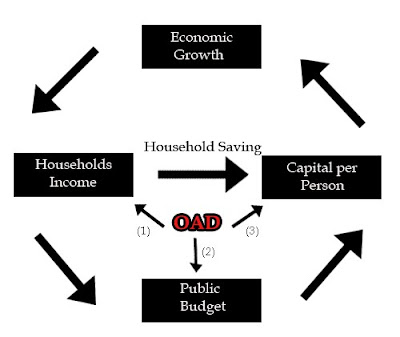
If there is only one magic bullet to put poverty into museum, Jeffrey Sach will definitely declare foreign aid investment as the sole remedy. He makes a bold statement in his book, "The End of Poverty", that impoverished countries are engulfed in the fire of extreme poverty; that the poor who inherit a series of misfortunes such as poor geography, infrastructure, health care, and human capital, are incapable of breaking themselves out from this vicious trap.
He later draws an analogy of a human body to explain the complexity of each society and that economist should be attuned to all possible symptoms that a country has, just like a doctor approaches his patient: he analyzes the diseases, run some tests and then prescribes appropriate treatment. Thus, there is no one-size-fits-all remedy in economy, each economist should be well-versed to diagnose a country and come up with different treatments. This is what he calls "clinical economics".
In this framework, financial foreign aid or what Sach often refers to Official Development Assistance (ODA), fits nicely. He argues that rich countries hold the destiny of poor countries and that the rich is responsible to set the poor development effort in motion. On other words, the U.S. and other developed countries should assist and lift the poor until they are able to grab the first rung of the development ladder. How? This is where things get arduous, but let me simplify.

A household will always have three streams of expense (1) Consumption (2) Tax Payments and (3) Savings. In the case of extreme poverty, the household income is absorbed completely to satisfy basic consumption, leaving zero dollar for tax and let alone savings. Without tax, the government could not make necessary public investment. As a result of zero tax and saving, capital per person suffers tremendously. Add to that picture is the problem of population growth and depreciation which both bring down the level of capital per person. Follow the cycle and a freshman in economy would be able to predict that the economy is contracting, leaving households with only enough means to satisfy basic needs and ensnaring the country, again, in this vicious cycle of poverty trap.
 OAD (or financial aid) is a booster. It jumpstarts the economy by feeding into three different channels, (1) humanitarian aid to meet households' basic needs which hopefully then increase saving, (2) budget to finance public investment, (3) microfinance program for private business. All of which are directed to increase the level of capital per person. The corollary once these investments are in motion are that households would be able to rise beyond subsistence, the poverty trap is broken, and the economy is lubricant enough to be self-sustaining.
OAD (or financial aid) is a booster. It jumpstarts the economy by feeding into three different channels, (1) humanitarian aid to meet households' basic needs which hopefully then increase saving, (2) budget to finance public investment, (3) microfinance program for private business. All of which are directed to increase the level of capital per person. The corollary once these investments are in motion are that households would be able to rise beyond subsistence, the poverty trap is broken, and the economy is lubricant enough to be self-sustaining.Having understood this, let's incorporate the "clinical economy" theory to this picture. Each country has its own malady and the amount of investment (OAD) to be injected differ from country to country. Thus, it is imperative to know and locate which specific-capital in the country that require greater attention and investment. In general, there are six crucial capitals (Business, Human, Knowledge, Infrastructure, Natural, and Public Insitutional), and comprehensive effort should be made to address all six. Missing one of these would be imicable as each capital is greatly contingent on another capital; ignoring one destroys the whole equation.
I've been explaining a mouthful and it's time for me to stop. Bottom line is, the glorious dream of ending poverty is attainable. What the world need now is for the affluent countries to start investing in these impoverished countries at least until they get a hold on the first rung of development ladder. That's all to it, just like Sach said, "it is not whether the rich can afford to help the poor, but whether they can afford not to."